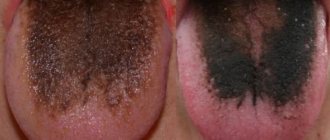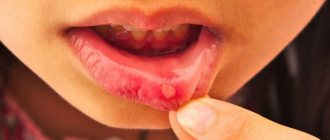1.General information
The apt, albeit somewhat frivolous name “geographic tongue” refers to the inflammatory-dystrophic process in the mucous membrane of the tongue, also known as “wandering glossitis”, “migratory oral erythema”, “exfoliative glossitis” (formulation in ICD-10), “desquamative glossitis”, etc. Exfoliative in translation means “flaky”, desquamative means “deprived of scales”, glossitis is inflammation of the tongue. Peeling of the epithelium in combination with inflammation and dystrophic changes together form red and white patterns on the tongue, which in many cases really resemble a fragment of a geographical map.
In different historical periods in medicine, there were different views on the essence and pathogenesis of desquamative glossitis (the term and concept were introduced into the medical paradigm in 1831), and the discussion continues to this day. Thus, some authors consider this process to be neurodegenerative, others to be purely inflammatory, and others generally consider it as a non-pathological variant of the norm.
The prevalence of “geographic language” varies significantly depending on the age, gender, and clinical composition of the studied samples; in terms of the general population, it is estimated at 2-5% of the population. There is a slight predominance of women, children and adolescents.
A must read! Help with treatment and hospitalization!
Home methods
In general, people who develop this disease do not require special treatment or medical intervention. The epithelium peels off within a few weeks or months, and everything disappears on its own. But what treatment is needed when it has been bothering you for quite a long time and there is no visible path to recovery?
The most important thing for the treatment and prevention of geographic tongue is constant oral hygiene. It is especially important for children with a folded tongue, since such structural features are very suitable for the development of bacteria, which, together with glossitis, can lead to inflammation, which is accompanied by pain
Treatment of geographic tongue in both children and adults should begin with rinsing with a variety of herbs and tinctures. Decoctions of chamomile and St. John's wort have a very good effect.
Sunflower oil also has medicinal qualities, so doctors recommend keeping it in your mouth for up to ten minutes. But first it needs to be sterilized. To do this, the bottle is placed in boiling water and removed only after twenty minutes. Rinsing your mouth with fresh green tea reduces inflammation and relieves discomfort.
Fish oil, oil, and Vaseline, which is soaked in a gauze pad and applied to the tongue, can also help a lot. You need to keep this gauze for 5 minutes.
To avoid further exacerbations or recurrence of the disease, it is better to limit children to spicy, salty and very cold, hot foods.
In this way, with the right actions on time and following hygiene rules, geographic tongue will not cause any harm to your baby.
Disquamative glossitis usually goes away on its own, and by focusing on it, you may miss a really serious disease that could provoke the appearance of a geographic tongue. Therefore, it is necessary to find out the reasons through examination.
The doctor will identify possible causes and prescribe the correct treatment. The main thing is to follow all his recommendations and then all the symptoms - spots, redness, enlargement of the tongue - will gradually pass and no serious changes will occur in the child’s health.
Fortunately, the treatment of geographic tongue is mostly done without medications, which is undoubtedly a plus.
The main thing is to teach your child the rules of personal hygiene from early childhood. And not just tell them that you need to brush your teeth twice a day and change your toothbrush every three months, but also demonstrate all this by example.
Sometimes geographic tongue is not a symptom of any disease, then it makes sense to use home treatment methods. It is worth noting that most of the folk recipes can significantly alleviate the patient’s condition, since they are symptomatic therapy. In particular, it makes sense to turn to them if the problem causes discomfort in the form of itching, pain while eating, etc. Recipes for home remedies:
- Rinse with a solution of iodine and soda. You need to dissolve 2 drops of iodine and half a teaspoon of soda in a glass of water. Rinse your mouth twice a day after meals.
- Vegetable oil is also used for rinsing the mouth. However, it must be sterilized first. To do this, the oil must be placed in a steam bath for 30 minutes.
- You can rinse your mouth with medicinal herbs - use St. John's wort, chamomile, oak bark. Any rinsing should be done for 2 or more minutes, and after that, do not eat for 15 minutes.
- Gauze napkins soaked in oil—vaseline, rosehip, peach, or fish oil—have medicinal properties. They must be applied to the tongue for 5-10 minutes.
- Baths for the oral cavity. They will need vegetable oil, which must be kept in a water bath for 30 minutes to sterilize. Place warm (not hot) oil in your mouth for 3-5 minutes and spit out.
- Traditional healers recommend keeping honey in your mouth, dissolving it gradually. The tasty medicine has bactericidal and healing properties. In addition, honey improves immunity. Another beekeeping product, propolis, also provides a powerful healing effect. Alcohol tincture (1 tsp) should be added to water (200 ml) and rinse the mouth with this solution.
Honey is a tasty and healthy medicine for the tongue, but before use you need to make sure that the child is not allergic to bee products
2. Reasons
There is no single point of view regarding the etiopathogenesis of inflammatory desquamation of the tongue; the issue continues to be studied and discussed. According to the most reasoned hypotheses, the cause may be infections (both bacterial and viral), hereditary predisposition, diseases of the liver, pancreas, gastrointestinal tract (primarily gastritis, gastroduodenitis, peptic ulcer and intestinal malabsorption syndrome), endocrine and metabolic disorders, exudative diathesis in children, autoimmune diseases, helminthiasis.
Visit our Gastroenterology page
Concept
Geographical language in a child - photo :
Geographical language - what does it mean? Doctors define geographic tongue as a disease that affects the mucous membrane of the tongue . The process is inflammatory and develops quite quickly.
Characterized by peeling of the tongue. The lesions are red in color and have borders that appear as white epithelium.
At first, the baby does not feel anything special, but over time, itching occurs in the tongue area.
3. Symptoms and diagnosis
The first manifestations are usually small, up to several millimeters, light gray lesions. Then such an area from the center turns red and swells somewhat, beginning to protrude above the surface and become covered with red papillary dots. The shape of desquamation foci can be very different, from round to arched. The alternation of inflamed, exfoliated and keratinized areas (usually they are multiple) forms a bizarre picture that can change quite quickly. The process is usually localized on the upper and lateral surfaces of the tongue, sometimes spreading to the lower areas.
In rare cases, desquamative glossitis causes subjective discomfort at the level of sensations - usually a burning or tingling sensation, less often pain when eating. In most cases, the disease is asymptomatic, for years or even decades; A recurrent (recurrent) type of course with long-term remissions is often noted.
To establish a diagnosis, an examination, collection of complaints (if any) and anamnesis are usually sufficient. However, given the importance of desquamative glossitis as a possible indicator of serious diseases, a multifaceted laboratory study is indicated (they begin with the appointment of general clinical and biochemical tests).
About our clinic Chistye Prudy metro station Medintercom page!
Types of plaque and reasons for its appearance
To understand why the tongue becomes spotted, you need to take a closer look at the plaque covering it. Usually it precedes spots that form as a result of a violation of its structure or after the plaque “peels off.” The film on the tongue of an infant or older child can be of the following shades:
Thin white coating. Often observed in newborns and children in the first year of life. Appears in the morning, structurally it is a thin, transparent film of whitish color. It is enough to remove the deposits with a damp gauze swab so that they no longer appear during the day. This plaque is an allergic reaction of the baby to an artificial formula or to foods that make up the mother’s diet (during breastfeeding).
- Curdled white coating. A dense film of rich white color with hidden ulcers, foul-smelling and difficult to remove - a symptom of thrush (candidiasis) or stomatitis. In infants with such diseases, instead of a solid plaque, white spots of very impressive size often form.
- Yellow plaque.
Formed when there is a malfunction of the child’s liver, kidneys or bile ducts. Fungal infection of the tongue Gray coating. The initial sign of dangerous childhood diseases - scarlet fever and diphtheria. Sometimes this appearance of the taste organ indicates severe dehydration. In both cases, you need to start treating the root cause of the symptom as soon as possible, since such diseases are dangerous not only for the health, but also for the life of the baby.
Read also: How to treat stomatitis on a child’s lip
Plaque in the form of green spots. The manifestation indicates a fungal infection in the oral cavity of a small patient. Usually the rash spreads to the palate, cheeks, and mucous membranes of the lips.
Brown deposits. The result of a malfunction of the digestive system, accompanied by stagnation of bile in the bile ducts. In infants, the symptom often signals dehydration; in older children, it indicates a deficiency or malabsorption of B vitamins. In addition, if brown spots appear on the baby’s tongue, an allergy to herbs can be suspected, even if the nursing mother takes them.
Black deposits. They are a consequence of taking certain antibiotics, overdose or the body’s rejection of the drug. Sometimes the reasons for the appearance of black plaque lie in intestinal disorders: colitis, enteritis and gastritis.
4.Treatment
In cases of asymptomatic disease, if there are no signs of underlying somatic diseases, therapy is not required and is not prescribed. The exception is the mandatory sanitation of problematic teeth and oral cavity, as well as normalization of the diet - which, however, is indicated for absolutely all people.
If there are symptoms of a particular disease that may be the cause or basis for the development of desquamative glossitis, the patient is referred to a specialist of the appropriate profile, where he receives etiopathogenetic treatment.
Doctor Komarovsky's opinion
Well-known pediatrician and TV presenter Evgeny Komarovsky advises not to panic about geographic tongue - this phenomenon does not pose a danger to the child. This doesn't mean you should ignore it. An examination will not hurt, since there are reasons for the strange coloring of the surface of a child’s tongue. In the meantime, while the examination is underway, the parent needs to take several measures that will help cope with the annoying problem faster and more efficiently:
it is important to give the child soft food so that he does not have the opportunity to scratch or injure his tongue with rough, hard food; You should not give your child anything too salty, spicy or sour - additional irritation of the tongue is absolutely useless; if there is itching, it is important to ensure that the child does not scratch the tongue or drag foreign objects into the mouth - the presence of wounds on the lingual surface can be complicated by infection; it is important to consult a pediatrician about vitamins - very often the geographical language indicates the presence of one or another type of vitamin deficiency; There is no need to rush to intensively treat the child with medications - in most cases, home rinses and lotions are enough to rid the child of a strange pattern on the tongue in a couple of weeks.
Features of therapy for parasitic infestations in children
A parasitic disease is the development of painful symptoms as a result of the activity of a helminth or protozoa in the human body [1]. The main factor in the survival and spread of parasites is their unusually high reproductive capacity, as well as constantly improving mechanisms of adaptation to living in the human body. Unfortunately, the alertness of medical workers regarding parasitic diseases among the population is currently extremely low, and the prevention of helminthiasis is reduced to the treatment of identified infested patients [12, 13]. At the same time, many researchers note the connection between the widespread prevalence of parasitosis in the child population and the development of functional pathology of the digestive organs against the background of regulatory disorders and the high risk of developing chronic diseases even if the child is naturally rehabilitated over time.
The most common and studied diseases - ascariasis, enterobiasis (Fig. 1) and giardiasis - are registered everywhere. In Russia, more than 2 million patients with nematodes are diagnosed annually. When assessing the territorial distribution of giardiasis in Russia, it was found that the highest average level of incidence rates over many years was noted in St. Petersburg, and the incidence of children attending child care institutions was 35% [2].
Each person repeatedly experiences various parasitic diseases during his life [9]. Parasitosis is more common in childhood. In young children (under 5 years of age), this is facilitated by the widespread prevalence of reproductive material of parasites (cysts, eggs, larvae (Fig. 2)) in the environment and insufficient development of hygienic skills.
Periods of transient weakening of the immune defense of the mucous membranes of the digestive tract are also important. Peaks of detected parasitic diseases in children are observed at the ages of 2–3 years, 4–7 years, and 10–14 years. In the morbidity structure, the share of young children and schoolchildren reaches 95% among all registered patients with enterobiasis and 65% among patients with ascariasis [1].
These periods of a child’s life are characterized by intense adaptation processes and a decrease in defense reserves, along with intense environmental influences. Comparison of the significance of the criteria that determine the characteristics of the selected age segments (mass-growth “jumps”, critical periods of development of the immune system, peaks of primary morbidity) allows us, first of all, to highlight the level of metabolism that increases at this time in the child’s body, aimed at ensuring the mass-growth spurt. This condition is beneficial for parasites, since the main task of their life activity is the production of a huge amount of reproductive material (eggs, cysts), which also first of all requires a very high intensity of metabolic processes. For example, with giardiasis, up to 12 million cysts are released in 1 g of feces of a sick person [4, 8].
The importance of certain risk factors varies according to the age of the child. It has been proven that for young children, sanitary and hygienic living conditions are more important, and for adolescents, when collecting anamnesis, it is necessary to pay attention to socio-economic and geographical factors (staying in a camp, a tourist trip, the presence of a younger brother or sister) (Fig. 3).
A transient decrease in anti-infective immunity as a risk factor for the occurrence of parasitosis in children is also recorded during the period of convalescence after viral diseases caused by viruses of the herpetic group (cytomegalovirus, herpes simplex virus I and II, Epstein-Barr virus), and may arise as a result of iatrogenicity (the use of immunosuppressive therapy for allergic and autoimmune diseases). Currently, a significant proportion of children are in a state of maladaptation, which is also accompanied by a decrease in immune defense.
The immune defense of the child’s gastrointestinal tract (GIT) can be divided into specific and nonspecific. Nonspecific protection includes a set of conditions for normal digestion: the maturity of enzymatic systems, the provision of an acid-base gradient in various parts of the gastrointestinal tract, the activity of normal microflora, and adequate motility.
In some cases, nonspecific protection may be impaired. For example, the maturity of enzyme systems depends on the biological age of the child, which does not always coincide with the passport age. Often this so-called phenomenon of delayed enzymatic start is included in the phenotype of a child with diffuse connective tissue dysplasia. This phenotype may also include the following specific signs: anomalies in the development of the auricle, a “Gothic” palate, epicanthus, hypertelorism, joint hypermobility syndrome, minor anomalies in the development of the heart, gallbladder, etc. The existing functional deficiency of enzyme systems in such a child is combined with changes in elasticity and the strength of the gastrointestinal tract wall, creating a predisposition to the occurrence of functional disorders of the digestive organs. Studies have proven that in children with more than 5 of the above minor developmental anomalies, parasitic infestations are observed in 78% of cases, while in the control group the incidence of parasitosis was less than 45% [3, 6].
Separately, it should be noted that for a disease such as giardiasis, a predisposing factor for invasion is the irregular and insufficient secretion of bile into the intestines due to abnormalities in the development of the gallbladder (constrictions, kinks). Giardiasis identified in patients of the pediatric department of MONIKI was accompanied by biliary tract dysfunction in 100% of cases.
In children in the recovery period after acute intestinal infections, after massive antibiotic therapy, as well as in patients with chronic pathology of the digestive organs, concomitant disturbances in enzyme support, normal flora and intestinal motility also make the gastrointestinal tract more vulnerable to parasites (Fig. 4).
Specific protection of the mucous membrane of the digestive organs depends on the child’s age and maturity. The mechanism of specific immune defense is one of the most ancient systems of the body, since helminthiases have accompanied humanity for many millennia. This mechanism is represented primarily by blood eosinophils and immunoglobulin E.
The classic extensive antiparasitic response can be formed in a child no earlier than 4 years of age and is closely related to the quality and quantity of IgE that matures by this age. When the body comes into contact with the parasite, inflammatory mediators are primarily released: interleukin, leukotriene C4, D4, prostaglandins, thromboxanes. The number of lymphocytes producing IgM and IgG increases. In a clinical blood test, an increase in the level of eosinophils and basophils is noted, associated with an increase in the content of these cells in the tissues of the invaded organ. When meeting parasite larvae, tissue basophils secrete heparin and histamine, which, in combination with leukotrienes and other inflammatory mediators, cause general symptoms: itching, reactive edema, hyperemia, and can also provoke general symptoms: bronchospasm, manifestations of urticaria or diarrhea. Allergic inflammation during parasitosis develops along the classical path and is intended to create conditions leading to the death and/or elimination of the parasite [5].
At the same time, eosinophils have a pronounced cytotoxic potential that exceeds the capabilities of other blood cells, which explains the primary importance of eosinophils in antiparasitic reactions and their damaging role in allergies. Eosinophils have their main effect in barrier tissues. At the site of invasion, they degranulate, exerting helminth-toxic and cytotoxic effects. Eosinophil granule proteins (large basic protein, eosinophil peroxidase, eosinophil cationic protein, eosinophil-derived neurotoxin) are toxic not only to the parasite, but also to the cells of the child's body. Another important cause of systemic and organ damage accompanying parasitosis is the formation of immune complexes [9, 10].
The effect of parasites on a child’s body involves many systems. Almost all of their types can cause a shift in the Th1/Th2 cell ratio in a direction favorable for their survival. Cases have been described in which parasite excretion products had a hormone-like effect on the host organism [5].
Parasites exert their local influence by causing contact inflammation of the mucous membrane and stimulating autonomic reactions. In this case, the processes of intestinal absorption, adequate motility of the gastrointestinal tract and its microbiocenosis are disrupted.
The systemic effect is due to the parasite’s use of the energy and plastic potential of food to the detriment of the child’s body, induction of allergies and autoimmune processes, targeted immunosuppression and endogenous intoxication. Studies have shown that allergic syndrome accompanies ascariasis and enterobiasis in 71.3% of cases. Among children with atopic dermatitis, parasitosis is detected in 69.1%, with giardiasis accounting for 78.5% of all invasions [4].
A particularly recognizable clinical picture is formed by toxocariasis (Fig. 5). Clinical markers of this invasion are the leukemoid reaction of eosinophils (20% or more eosinophils in the blood count), accompanying a pronounced and persistent allergic syndrome in the form of atopic dermatitis with severe itching and resistance to traditional therapy or severe bronchial asthma with frequent attacks.
In 75.3% of cases, parasitosis is accompanied by various functional disorders of the gastrointestinal tract. A number of studies have proven that parasitic invasion can cause disturbances in carbohydrate metabolism, as well as disaccharidase deficiency due to a decrease in lactase levels [7, 9].
Parasitic infestations, as a rule, are accompanied by neurotic reactions of varying degrees of severity, in particular, Giardia is not without reason called “parasites of melancholy and sadness.”
In most children, adaptation disorders are one of the important links in the pathogenetic process of parasitosis. It should be noted that the state of maladaptation primarily affects the lymphocytic link of immunogenesis, which cannot but affect the maturation and differentiation of specific immunity.
Diagnosis of parasitosis
Until now, the search for a simple, accessible and reliable method for diagnosing parasitosis is ongoing. The developed methods of direct visual detection require minimal exposure to diagnostic material and multiple repeated studies. Known methods for diagnosing helminthic infestations and protozoa, such as the Kato thick fecal smear method, the formalin-ether deposition method, perianal scraping, microscopy of bladder and hepatic bile, have a number of disadvantages associated both with the developmental characteristics of the parasite and with the state of the macroorganism and its reactivity.
However, the effort expended may be useless if the study is carried out during a pause in the production of cysts or eggs. For example, the uninformativeness of perianal scraping with a 1–2-fold examination method is due to the frequency of oviposition by female pinworms. The peculiarity of the excretion of cysts by Giardia is called the “phenomenon of intermittent cyst excretion,” in which the phases of massive cyst excretion are replaced by a negative phase, which can last from 2–3 days to 2–3 weeks. During this period, it is impossible to detect Giardia in feces.
Indirect research methods (determination of specific antibodies) lack specificity and reliability. It is known, for example, that, going through a complex development cycle from egg to adulthood, helminths change their antigenic composition. Antibodies in the host's body are produced mainly in response to the intake of helminth excreta and secretions, while somatic antibodies are used in immunodiagnostic reactions. The emerging nonspecific sensitization of the body, the commonality of some antigens of trematodes, protozoa and humans create a high proportion of false-positive serological reactions in titers below the reliably diagnostic ones. Thus, testing by enzyme immunoassay (ELISA) for helminths is a highly sensitive but low specific method. Determination of parasites using the polymerase chain reaction (PCR) method is a highly specific and highly sensitive method, but due to its high cost and complexity it cannot be used for screening when, for example, it is necessary to examine a group of children from a children's institution.
The clinical examination of the child and careful consideration of indirect signs of parasitosis do not lose their relevance. It is important to note the possibility of parasitosis in allergic and asthenic syndrome, polylymphadenopathy of unknown origin, impaired intestinal absorption, carbohydrate metabolism, protracted and chronic course of diseases of the digestive tract, hepatosplenomegaly of unknown origin. The course of parasitic infestation has clinical features: usually the signs of damage are minimized, the disease is of a muted nature, exacerbations are polymorphic and dim. A feature of exacerbations of diseases in this group is their cyclical nature with a period of 11–15 days.
Indirect laboratory signs of parasitosis can be anemia, basophilia, eosinophilia, and an increase in the level of aspartate aminotransferase (AST).
In addition, signs of possible parasitic invasion should be taken into account when assessing the results of instrumental research. During an ultrasound examination of the abdominal organs in a child over 3 years of age, indirect signs of parasitosis are hepatosplenomegaly, unevenness of the liver and spleen parenchyma due to small hyperechoic signals, and enlarged lymph nodes in the hilum of the spleen.
Parasitic infestation determines the appearance and complaints of the child. Usually this is an emotionally labile and anxious child with dry pale skin, with signs of impaired regeneration of the skin and mucous membranes, with polylymphadenopathy, adenoid vegetations of the II-III degree, “jams” in the corners of the mouth, a “geographical” tongue, with a reduced or selective appetite, often with unstable stool. Various manifestations of allergic syndrome are also noted in the form of recurrent urticaria, persistent atopic dermatitis or broncho-obstructive syndrome.
Treatment of helminthiasis
Treatment of helminthiases should begin with the use of specific anthelmintic drugs. The modern arsenal of drugs used to treat intestinal parasitosis includes a significant number of drugs of various chemical classes [11]. They are used both in clinical practice for the treatment of identified patients, and for the purpose of mass prevention.
When determining a drug for specific antiparasitic therapy, it should be understood that the spectrum of action of these drugs is not particularly wide. Almost all drugs in this group have been used for many decades and it is reasonable to assume that the parasites have developed adaptation systems and the disease may be resistant to the therapy. According to G.V. Kadochnikova (2004), the effectiveness of such a traditional drug as Dekaris in modern conditions does not reach 57%. In addition, this group of antiparasitic drugs, unfortunately, has a number of side effects: nausea, vomiting, abdominal syndrome.
Thus, in modern conditions, preference should be given to more modern drugs, which, firstly, are universal for the treatment of both nematodes and mixed helminthic infestations and are active against such a common parasite as Giardia. Secondly, using one antiparasitic drug, rather than a combination of them, significantly reduces the risk of unpleasant side effects. Today, the only representative of this group in our country is albendazole (Nemozol).
To treat ascariasis in older children or when the disease recurs, a combination of anthelmintic drugs (for example, albendazole for three days, then Vermox for three days) can be used under medical supervision. An indispensable condition for successful deworming of patients with enterobiasis is the simultaneous treatment of all family members (team) and strict adherence to a hygienic regime to prevent reinfestation. It should be noted that daily wet cleaning is important, since occasional cases of pinworm reproductive material spreading on dust particles to a height of 1.5 meters have been described.
Treatment of giardiasis involves a mandatory diet with limited consumption of easily digestible carbohydrates, increasing the proportion of protein in food, consumption of “acidifying” products (decoctions of lingonberries, cranberries), and the use of choleretic decoctions and drugs.
In the pediatric clinic of MONIKI, principles of parasitosis therapy have been developed that take into account the characteristics of the pathogenesis of invasion and allow high-quality and reliable treatment of this group of diseases. Thanks to the use of the developed treatment regimen, it is possible to effectively prevent reinvasion and the development of functional disorders of the digestive organs in children.
Principles of therapy for patients with parasitosis
1. Taking antiparasitic drugs is carried out taking into account the type of causative agent of the invasion.
Drugs used in the treatment of ascariasis:
- Vermox (mebendazole) (for children over 2 years old) - 100 mg 2 times a day for 3 days;
- Pyrantel - 10 mg/kg once;
- Nemozol (albendazole) (for children over 2 years old) - 400 mg once.
Drugs used in the treatment of enterobiasis:
- Vermox (mebendazole) (for children over 2 years old) - 100 mg once;
- Pyrantel - 10 mg/kg once;
- Nemozol (albendazole) (for children over 2 years old) - 400 mg once.
Drugs used in the treatment of giardiasis:
- ornidazole 25–30 mg/kg (if body weight is more than 35 kg - 1000 mg) in two doses for 5 days, 1 day - 1/2 dose, repeat course after 7 days;
- Macmiror (nifuratel) - 15 mg/kg 2 times a day for 7 days;
- Nemozole (albendazole) - 15 mg/kg once for 5-7 days.
2. Treatment of parasitosis involves changes in the properties of the child’s digestive tract as a result of the vital activity of parasites (functional disorders of the digestive organs, fermentopathy, changes in microbiocenosis) and their correction with courses of enzyme preparations and synbiotics (Table 1).
3. Mandatory use of enterosorbents and a complex of multivitamins with microelements (Tables 2 and 3).
Thus, the principles of complex therapy of parasitosis in children, developed at the MONIKI pediatric clinic, provide for the gradual restoration of the functional state of the gastrointestinal tract, disturbed as a result of the local and systemic influence of parasites. The use of complex therapy makes it possible to prevent further development of functional disorders with the formation of organic pathology, as well as to avoid reinvasion.
Literature
- Avdyukhina T.I., Konstantinova T.N. et al. Enterobiasis. Clinic, diagnosis, treatment, epidemiology, prevention: Textbook. manual for doctors. M., 2003. 56 p.
- Blagova N.N. Some immunity factors in patients with ascariasis and enterobiasis during treatment with albendazole: Abstract of thesis. dis. ...cand. honey. Sci. St. Petersburg, 1997. 24 p.
- Human helminth infections / Edited by prof. V. I. Luchsheva, Doctor of Medical Sciences V. V. Lebedeva; manual for doctors. Krasnodar. Soviet Kuban, 1998; 124.
- Akhmetova R. A., Tupertseva G. T. et al. Diagnosis, treatment and prevention of giardiasis in children with chronic diseases of the digestive organs: method. recommendations. Ufa: Publishing house BSMU, 2008. 48 p.
- Izachik Yu. A., Izachik N. A. Immunology of the gastrointestinal tract in normal conditions and in pathological conditions. In: Immunology and immunopathology of childhood / D. V. Stefani, Yu. E. Veltishchev. M.: Medicine, 1996. pp. 327–351.
- Kadochnikova G.V. Ascariasis in children, improvement of diagnosis and treatment. Author's abstract. Ph.D. diss. Perm, 2004.
- Kopanev Yu. A., Sokolov A. L. Dysbacteriosis in children. M.: OJSC “Publishing House “Medicine”, 2008. 128 p.
- Korovina N. A., Zakharova I. N. et al. Diagnosis and treatment of giardiasis in children. A manual for doctors. M., 2006. 52 p.
- Lysenko A. Ya., Vladimova M. G., Kondrashin A. V., Majori J. Clinical parasitology. Under the general editorship. Lysenko A. Ya. Management. Geneva, WHO: 2002. 752 p.
- Markin A.V. Issues of prevention of the most important helminthiases in Russia // Journal. microbiol. 1995. No. 1. P. 106–108.
- Ozeretskovskaya N. N., Zalnova N. S., Tumolskaya N. I. Clinic and treatment of helminthiases. L., Medicine, 1985.
- Prevention of parasitic diseases on the territory of the Russian Federation; Sanitary rules and regulations. M.: Information and Publishing Center of the Ministry of Health of Russia, 1997; 168.
- Epidemiological surveillance of parasitic diseases. Methodical instructions. M., 2005. 82 p.
L. I. Vasechkina1, Candidate of Medical Sciences T. K. Tyurina, Candidate of Medical Sciences L. P. Pelepets, Candidate of Biological Sciences A. V. Akinfiev, Candidate of Medical Sciences
GBUZ MO MONIKI named after. M. F. Vladimirsky, Moscow
1 Contact information
What sensations does the child experience?
In the first stages, the disease does not manifest itself. The child may not feel sick.
Only in the later stages are burning and itching felt, which rapidly intensify . There is a tingling sensation on the tongue during and after eating.
Swelling of the tongue makes it difficult for the child to speak . Discomfort during a conversation increases greatly. If the disease is not treated, severe weakness will occur. The child will feel tired and drowsy.










